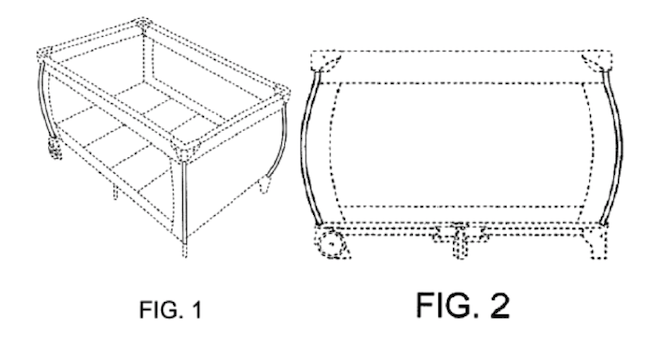“[T]he inventor’s own testimony must be corroborated by some competent independent evidence or testimony… an inventor cannot corroborate their own testimony relating to prior conception.
The Federal Circuit recently affirmed the Patent Trial and Appeal Board (PTAB) finding that two design patents were unpatentable as obvious. The Court found prior conception, diligence, and reduction to practice was not established by the uncorroborated inventor testimony. See Kolcraft Enters. v. Graco Children’s Prods., Nos. 2018-1259, 2018-1260, 2019 U.S. App. LEXIS 19751 (Fed. Cir. July 2, 2019) (Before Moore, Reyna, and Chen, Circuit Judges) (Opinion for the Court, Reyna, Circuit Judge).
Kolcraft Enterprises, Inc. is the assignee of U.S. Design Patent Nos. D604,970 and D616,231, both of which are related to children’s play yards. The patents described a play yard having four “exposed legs,” i.e., without fabric coverings. The following FIGs. 1 and 2 of U.S. Design Patent No. D604,970 are representative of the design in both patents:
Graco Children’s Products, Inc. filed a petition for inter partes review (IPR) challenging the two design patents in March of 2016. The challenge asserted that both patents were obvious in light of U.S. Design Patent No. D494,393 assigned to Chen. The PTAB instituted trial on the patents based on the obviousness challenge.
In its Patent Owner Response, Kolcraft provided an inventor declaration from inventors Troutman and Bretschger, and included Exhibits A–H with the declarations. The Exhibits were photos and sketches of play yards “that Troutman and Bretschger claim to have invented.” The declarations redacted all dates from when the exhibits were allegedly created. Before Graco deposed the inventors, Kolcraft provided an unredacted version of the declarations, “where the blank spaces were replaced with alleged dates of conception and reduction to practice.” During his deposition, Mr. Troutman alleged that the dates were provided from metadata associated with the images. Kolcraft provided the Board the unredacted version of the declarations one day before oral hearing. Neither the alleged metadata nor the computer files were provided.
The Board held that the evidence did not show conception, diligence, and reduction to practice prior to Chen’s filing. Furthermore, the Board did not find the inventor’s declarations to be “corroborated by non-inventor testimony, documents, or other evidence.”
In order for the testimony of the inventor to be accepted by any court — not just the PTAB — the evidence must be corroborated by other evidence. If the inventor testimony is not corroborated it cannot be used by the decision maker when reaching a decision. It is deemed insufficient from an evidentiary standpoint regardless of what it says or suggests. Thus, the PTAB did not consider the deposition testimony for the dates of conception. Accordingly, the PTAB found the design patents to be obvious in light of Chen, and Kolcraft appealed.
On appeal, the only issue considered by the Federal Circuit was whether the evidence was sufficient to support conception, diligence, and reduction to practice prior to Chen’s filing date. “Inventor testimony of conception must be corroborated by other, independent information.” (citing Apator Miitors ApS v. Kamstrup A/S, 887 F.3d 1293, 1295 (Fed. Cir. 2018)). The Judge Reyna explained that all evidence of prior conception originated from the inventors. The original Exhibits A–H did not include dates, and the only evidence of dates was provided by the inventors’ deposition testimony. Kolcraft argued the Exhibits did not need corroborating evidence because they are “‘physical exhibits’ that are self-explanatory.” (internal punctuation omitted). Of course, this is an incorrect statement of law. Documents are out of court statements and must be introduced properly with foundation for the document laid, which in this case since it was an inventor affidavit would require corroboration.
The representative of the inventor attempted to point to metadata contained within the inventor’s affidavit as being corroborating evidence showing the critical dates. The problem with this evidence was never made a part of the record, and the only place it was mentioned was in the inventor’s deposition, and it was only mentioned by the inventor. Inventor testimony must be corroborated by some competent independent evidence or testimony. Indeed, an inventor cannot corroborate their own testimony relating to prior conception. Therefore, an inventor deposition is insufficient to corroborate an inventor affidavit relying on what the inventor said in the deposition.

![[IPWatchdog Logo]](https://ipwatchdog.com/wp-content/themes/IPWatchdog%20-%202023/assets/images/temp/logo-small@2x.png)


![[[Advertisement]]](https://ipwatchdog.com/wp-content/uploads/2024/04/Patent-Litigation-Masters-2024-banner-early-bird-ends-Apr-21-last-chance-938x313-1.jpeg)


![[Advertisement]](https://ipwatchdog.com/wp-content/uploads/2024/04/Patent-Litigation-Masters-2024-sidebar-early-bird-ends-Apr-21-last-chance-700x500-1.jpg)

![[Advertisement]](https://ipwatchdog.com/wp-content/uploads/2021/12/WEBINAR-336-x-280-px.png)
![[Advertisement]](https://ipwatchdog.com/wp-content/uploads/2021/12/2021-Patent-Practice-on-Demand-recorded-Feb-2021-336-x-280.jpg)
![[Advertisement]](https://ipwatchdog.com/wp-content/uploads/2021/12/Ad-4-The-Invent-Patent-System™.png)







Join the Discussion
3 comments so far.
B
July 29, 2019 10:30 amOn one case, I literally had an examiner NOT perform a search in six years, but crappy examination is the rule in business methods. When the Examiner finally did perform a search, he produced a document that I attempted to swear behind, but literally more than 10 years since the date of reduction to practice had passed and most of the documentation was lost. Had he performed a search 2 years earlier, I’d have hundreds of thousand of lines of computer code available, which of course presents a different (but better) problem.
Talk about prejudicing a client. I suspect that, given the bias of the PTAB and the total incompetence of far too many APJs, this will go to the CAFC. Given that most CAFC judges don’t understand basic statutory construction or even what that “shepardize” button means, I’m not optimistic.
patent leather
July 29, 2019 01:17 amI was never a big fan of “first to invent” and this is another example why. It was unusual when second to file would actually get rights to an invention. Yet the second to file could cause enormous aggravation to the first to file. I didn’t read this case but sounds like it just restates the old golden rule that the inventor’s conception must be corroborated by a non-inventor. Which is why some lab notebooks had pages for a witness signature.
Paul F. Morgan
July 28, 2019 11:18 amAmazing how many times, for way more than a hundred years, this black letter law for trying to swear behind someone else’s earlier filing date has not been learned by so many patent attorneys.